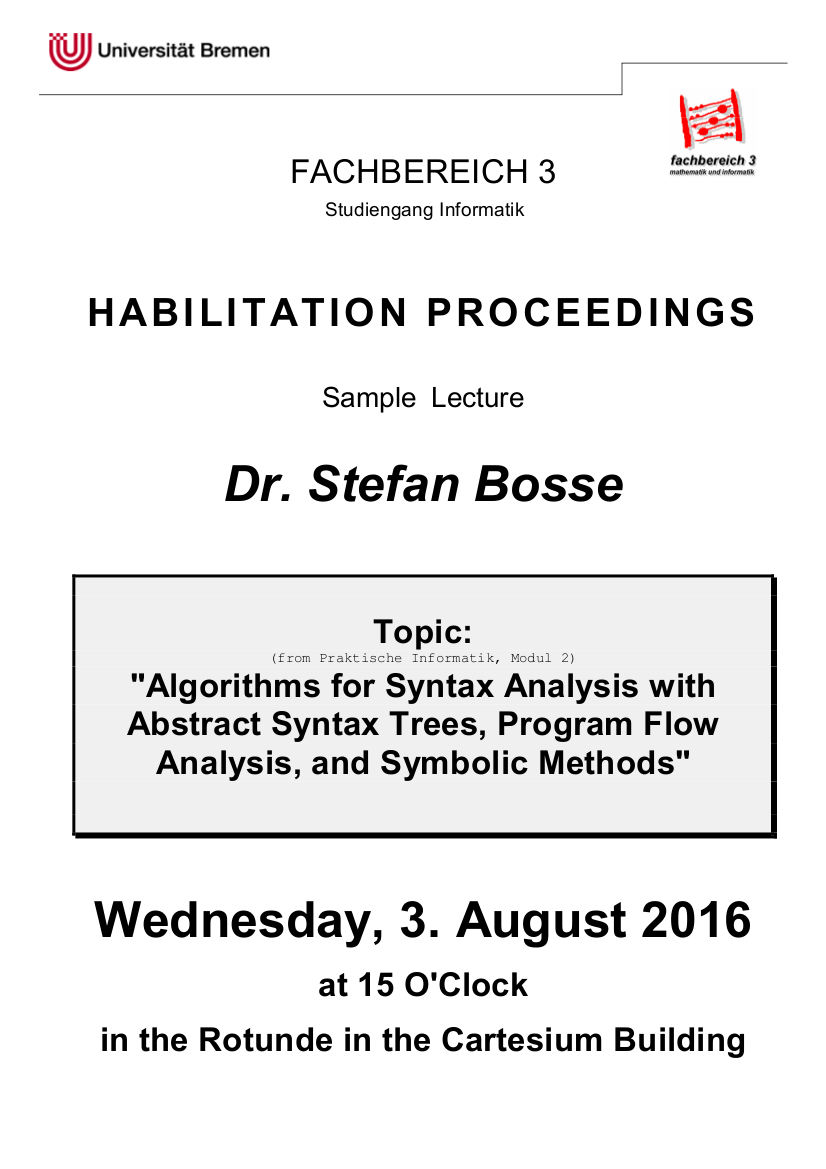Unified Distributed Sensor and Environmental Information Processing with Multi-Agent Systems
Synopsis
S. Bosse, Unified Distributed Sensor and Environmental Information Processing with Multi-Agent Systems: Models, Platforms, and Technological Aspects, epubli, published on 16.8.2018, 584 pages, ISBN 9783746752228 (Hardcover), ISBN 9783746759470 (Softcover) (2018)

Abstract
This book represents my Habilitation Thesis and addresses the challenges of unified and distributed computing in strong heterogeneous environments ranging from Sensor Networks to Internet Clouds by using Mobile Multi-Agent Systems. A unified agent behaviour model, agent processing platform architecture, and synthesis framework should close the operational gap between low-resource data processing units, for example, single microchips embedded in materials, mobile devices, and generic computers including servers.
Robustness, Scalability, Self organization, Reconfiguration and Adaptivity including Learning are major cornerstones. The range of fields of application is not limited: Sensor Data Processing, Load monitoring of technical structures, Structural Health Monitoring, Energy Management, Distributed Computing, Distributed Databases and Search, Automated Design, Cloud-based Manufacturing, and many more.
This work touches various topics to reach the ambitious goal of unified smart and distributed computing and contributing to the design of intelligent sensing systems: Multi-Agent Systems, Agent Processing Platforms, System-on-Chip Designs, Architectural and Algorithmic Scaling, High-level Synthesis, Agent Programming Models and Languages, Self-organizing Systems, Numerical and AI Algorithms, Energy Management, Distributed Sensor Networks, and multi-domain simulation techniques. None of these topics may be considered standalone. Only a balanced composition of all topics can meet the requirements in future computing networks, for example, the Internet-of-Things with billions of heterogeneous devices.
Smart can be defined on different operational and processing levels and having different goals in mind. One aspect is the adaptivity and reliability in the presence of sensor, communication, node, and network failures that should not compromise the trust and quality of the computed information, for example, the output of a Structural Health Monitoring System.
A Smart System can be considered on node, network, and network of network level. Another aspect of "smartness" is information processing with inaccurate or incomplete models (mechanical, technical, physical) requiring machine learning approaches, either supervised with training at design-time or unsupervised based on reward learning at run-time. Some examples of Self-organizing and Adaptive Systems are given in this work, forexample, distributed feature recognition and event-based sensor processing.
Content
- Introduction: Outline and Synopsis
- Agent Behaviour and Programming Model
- Agent Communication
- Distributed Sensor Networks
- Concurrent Communicating Sequential Processes
- PCSP: The Reconfigurable Application-specific Agent Platform
- PAVM: The Programmable Agent Platform
- JAM: The JavaScript Agent Machine
- Self-Organizing Multi-Agent Systems
- Machine Learning and Agents
- Simulation
- Synthesis
- Energy Management
- Use-Cases Environmental Perception, Load Monitoring, and Manufacturing
- Material-Integrated Sensing Systems
- Abbreviations, Notations, Symbols
- Publications and References
Impressions

Awarding of the Venia Legendi (Right: Prof. Michael Lawo), Jan. 2017

Announcement of Habilitation lecture
Printed Book
The printed book is available in two versions:
-
Hardcover binding and full color print, available from ePubli:
ePubli Book Hardcover
- Softcover binding and grey color print, available from ePubli:
ePubli Book Softcover
Electronic Book
- Frontcover
- PDF
- Preface
- PDF
- ToC
- PDF
- Chapter 1
- Introduction: Outline and Synopsis
OnlinePDF
- Chapter 2
- Agent Behaviour and Programming Model
OnlinePDF
- Chapter 3
- Agent Communication
OnlinePDF
- Chapter 4
- Distributed Sensor Networks
OnlinePDF
- Chapter 5
- Concurrent Communicating Sequential Processes
OnlinePDF
- Chapter 6
- PCSP: The Reconfigurable Application-specific Agent Platform
OnlinePDF
- Chapter 7
- PAVM: The Programmable Agent Platform
OnlinePDF
- Chapter 8
- JAM: The JavaScript Agent Machine
OnlinePDF
- Chapter 9
- Self-Organizing Multi-Agent Systems
OnlinePDF
- Chapter 10
- Machine Learning and Agents
OnlinePDF
- Chapter 11
- Simulation
OnlinePDF
- Chapter 12
- Synthesis
OnlinePDF
- Chapter 13
- Energy Management with Agents
OnlinePDF
- Chapter 14
- Use-Cases Environmental Perception, Load Monitoring, and Manufacturing
OnlinePDF
- Chapter 15
- Material-Integrated Sensing Systems
OnlinePDF
- Abbreviations
- PDF
- References
- OnlinePDF
- Backcover
- PDF
 Interdisciplinary Science & Education Laboratory
Interdisciplinary Science & Education Laboratory
 Interdisciplinary Science & Education Laboratory
Interdisciplinary Science & Education Laboratory


